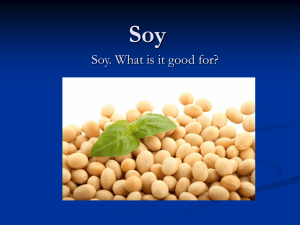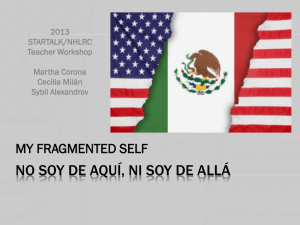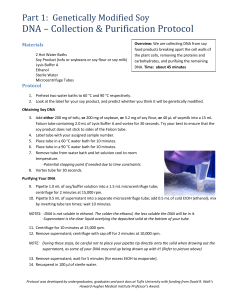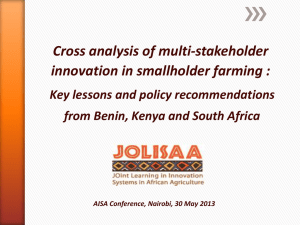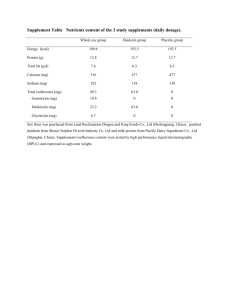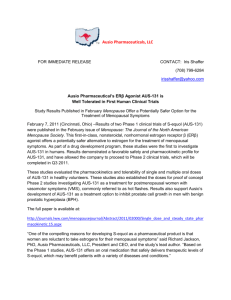ECS-soy-allergy - Healthy Eating Advisory Service
advertisement
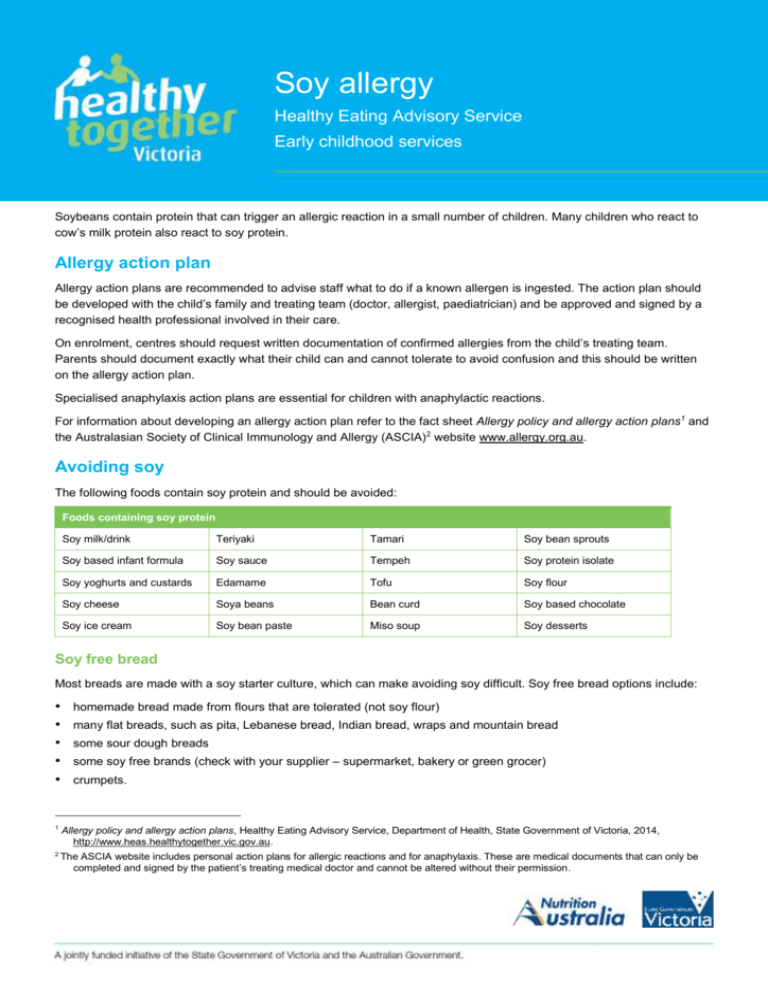
Soy allergy Healthy Eating Advisory Service Early childhood services Soybeans contain protein that can trigger an allergic reaction in a small number of children. Many children who react to cow’s milk protein also react to soy protein. Allergy action plan Allergy action plans are recommended to advise staff what to do if a known allergen is ingested. The action plan should be developed with the child’s family and treating team (doctor, allergist, paediatrician) and be approved and signed by a recognised health professional involved in their care. On enrolment, centres should request written documentation of confirmed allergies from the child’s treating team. Parents should document exactly what their child can and cannot tolerate to avoid confusion and this should be written on the allergy action plan. Specialised anaphylaxis action plans are essential for children with anaphylactic reactions. For information about developing an allergy action plan refer to the fact sheet Allergy policy and allergy action plans1 and the Australasian Society of Clinical Immunology and Allergy (ASCIA)2 website www.allergy.org.au. Avoiding soy The following foods contain soy protein and should be avoided: Foods containing soy protein Soy milk/drink Teriyaki Tamari Soy bean sprouts Soy based infant formula Soy sauce Tempeh Soy protein isolate Soy yoghurts and custards Edamame Tofu Soy flour Soy cheese Soya beans Bean curd Soy based chocolate Soy ice cream Soy bean paste Miso soup Soy desserts Soy free bread Most breads are made with a soy starter culture, which can make avoiding soy difficult. Soy free bread options include: • • • • • homemade bread made from flours that are tolerated (not soy flour) many flat breads, such as pita, Lebanese bread, Indian bread, wraps and mountain bread some sour dough breads some soy free brands (check with your supplier – supermarket, bakery or green grocer) crumpets. 1 Allergy policy and allergy action plans, Healthy Eating Advisory Service, Department of Health, State Government of Victoria, 2014, http://www.heas.healthytogether.vic.gov.au. 2 The ASCIA website includes personal action plans for allergic reactions and for anaphylaxis. These are medical documents that can only be completed and signed by the patient’s treating medical doctor and cannot be altered without their permission. Label reading In Australia all packaged foods must include a food label with an ingredients list. By law, all potential food allergens (peanuts, tree nuts, seafood, fish, milk, eggs, soybeans and wheat) must be clearly identified, no matter how small the amount. If an ingredient includes soy, this should be listed on the ingredients list. For example, if a product contains hydrolysed vegetable protein, it should be listed as ‘hydrolysed vegetable protein (soy)’ or ‘hydrolysed soy protein’. When purchasing packaged items, carefully check the food label and ingredient list for soy products. Check these each time the product is purchased, as ingredients and processing techniques may change. The following table outlines foods and ingredients which may include soy. Check labels to determine whether products should be avoided. Foods that may contain soy protein Most regular breads (contain soy flour) Meat substitutes Ice creams and ice confection Baked goods e.g. biscuits, cakes, pastries Crumbed meats and fish Chocolate flavourings, chocolate nut spread, chocolates and sweets Cake and pancake mixes Textured vegetable protein Flavoured milk drinks Homemade bread mixes Hydrolysed vegetable protein Gelato and sorbet Cereals including baby cereals Vegetarian foods Pizza Taco shells Sauces and soup mixes Flavourings Gravy and stock cubes Deli salads Mayonnaise Note: Many ‘allergy’ food products contain soy flour e.g. wheat free flours, bread mixes, pancake mixes. Do all soybean based ingredients need to be avoided? Soy emulsifier, soy lecithin (additive 322) and soy oil are made from the fat component of soybeans and the chance of an allergic reaction to these ingredients is unlikely. However some children are very sensitive and may still react to these products. Be guided by parents about what the child tolerates at home. As a precaution, families should document in writing on allergy action plans what can and cannot be tolerated so that the centre is clear about what their expectation is. ‘May contain traces of soy’ This statement is used by manufacturers to indicate that products may be contaminated with soy during processing and packaging. At present ‘May contain traces of soy’ is a voluntary statement and there are no clear guidelines to direct food companies how and when it should be used. The wording of this statement makes it very difficult to determine risk level and a product that does not include the statement may be no safer than a product that does. The risk of significant allergic reaction through contamination during processing is extremely low. Many families choose to ignore ‘May contain traces of soy’ statements as the only safe alternative is to exclude all commercial food products from the diet. As above, be guided by parents about what the child tolerates at home and ask families to document this in writing on allergy action plans. Adapted with permission from: Soy Allergy, Department of Allergy and Immunology, Royal Children’s Hospital Melbourne, November 2010. Other references: Dietary avoidance - soy allergy, Australasian Society of Clinical Immunology and Allergy, 2013, http://www.allergy.org.au/patients/food-allergy/ascia-dietary-avoidance-for-food-allergy/soy. To receive this document in an accessible format 1300 22 52 88 or email heas@nutritionaustralia.org Except where otherwise indicated, the images in this publication show models and illustrative settings only, and do not necessarily depict actual services, facilities or recipients of services. © Copyright State of Victoria, Department of Health 2014 Soy allergy 2

